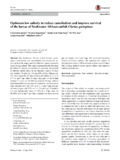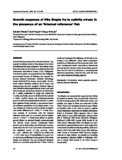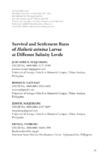Optimum low salinity to reduce cannibalism and improve survival of the larvae of freshwater African catfish Clarias gariepinus
Share
စိတ္တဇ
The freshwater African catfish Clarias gariepinus is carnivorous and cannibalistic even during the larval and juvenile stages and this behavior causes economic losses in aquaculture. This study examined for the first time the effect of salinity on cannibalism, survival, and growth of African catfish larvae in the hatchery. Larvae (4 days old, median 7.8 mm TL, 2.8 mg BW) of the African catfish were reared for 21 days at nominal salinity 0, 1, 2, 3, 4, 5, 6, and 7 ppt. After 21 days, they grew to 10–39 mm (median 22 mm) and 10–490 mg (median 90 mg), with no significant difference by salinity treatments. Survival ratios were similarly low (24–31%) at 0, 1, 3, and 7 ppt and significantly higher (49–55%) at 2, 4, 5, and 6 ppt. Cannibalism was significantly lower, 15–30% at 4–6 ppt, than the 40–50% at 0–3 and 7 ppt. Size variation was lower at 4–6 ppt and higher at 0–3 and 7 ppt. We recommend hatchery rearing of African catfish at the optimum low salinity of 4–6 ppt rather than in full fresh water at least up to 21 days. This rearing method fosters larval welfare and improves hatchery production.
Suggested Citation
Kawamura, G., Bagarinao, T., Yong, A. S. K., Sao, P. W., Lim, L. S., & Senoo, S. (2017). Optimum low salinity to reduce cannibalism and improve survival of the larvae of freshwater African catfish Clarias gariepinus. Fisheries Science , 83(4), 597-605. https://doi.org/10.1007/s12562-017-1088-y
ဘာသာရပ်
inland water environment  ; juveniles
; juveniles  ; larvae
; larvae  ; salinity
; salinity  ; aquaculture
; aquaculture  ; salinity effects; survival
; salinity effects; survival  ; rearing techniques
; rearing techniques  ; cannibalism
; cannibalism  ; predators
; predators  ; growth
; growth  ; carnivorous animals
; carnivorous animals  ; hatcheries; fresh water
; hatcheries; fresh water  ; methodology
; methodology  ; ratios; aggressive behaviour
; ratios; aggressive behaviour  ; osmoregulation
; osmoregulation  ; freshwater catfish
; freshwater catfish  ; Size variation; Clarias gariepinus
; Size variation; Clarias gariepinus 
 ; juveniles
; juveniles  ; larvae
; larvae  ; salinity
; salinity  ; aquaculture
; aquaculture  ; salinity effects; survival
; salinity effects; survival  ; rearing techniques
; rearing techniques  ; cannibalism
; cannibalism  ; predators
; predators  ; growth
; growth  ; carnivorous animals
; carnivorous animals  ; hatcheries; fresh water
; hatcheries; fresh water  ; methodology
; methodology  ; ratios; aggressive behaviour
; ratios; aggressive behaviour  ; osmoregulation
; osmoregulation  ; freshwater catfish
; freshwater catfish  ; Size variation; Clarias gariepinus
; Size variation; Clarias gariepinus 
စုစည်းမှုများ စုစည်းမှုများ
- AQD Journal Articles [1231]
Related items
Showing items related by title, author, creator and subject.
-
Growth response of Nile tilapia fry to salinity stress in the presence of an ‘internal reference’ fish
Basiao, Zubaida U.; Eguia, Ruel V.; Doyle, Roger W. (Blackwell Publishing, 2005)Growth of three strains of Oreochromis niloticus L. fry exposed to salinity stress in the presence of an internal reference fish were compared. The Central Luzon State University (CLSU) strain was obtained from the Freshwater ... -
Survival and settlement rates of Haliotis asinina larvae at different salinity levels
Maquirang, Jean Rose H.; Caturao, Romeo D.; Maquirang, Jessy H.; Pedroso, Fiona L. (IAMURE Multidisciplinary Research, 2013)The study was conducted to determine the optimum salinity levels (24 ppt, 28 ppt, 32 ppt, 36 ppt and 40 ppt) for the survival and settlement rates of H. asinina in a complete randomized design with three replicates each. ... -
Assessment of stocks of a natural Gracilaria population on Panay Island, Philippines
de Castro, Teresa R.; Guanzon, Nicholas G., Jr.; Luhan, Maria Rovilla (Walter de Gruyter, 1991)Two peaks in biomass were recorded from natural beds of Gracilaria sp. at Leganes, Iloilo and Batan, Aklan study sites. The major peak occurred in February 1989 for both areas. The minor peak occurred in September 1988 at ...




